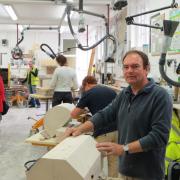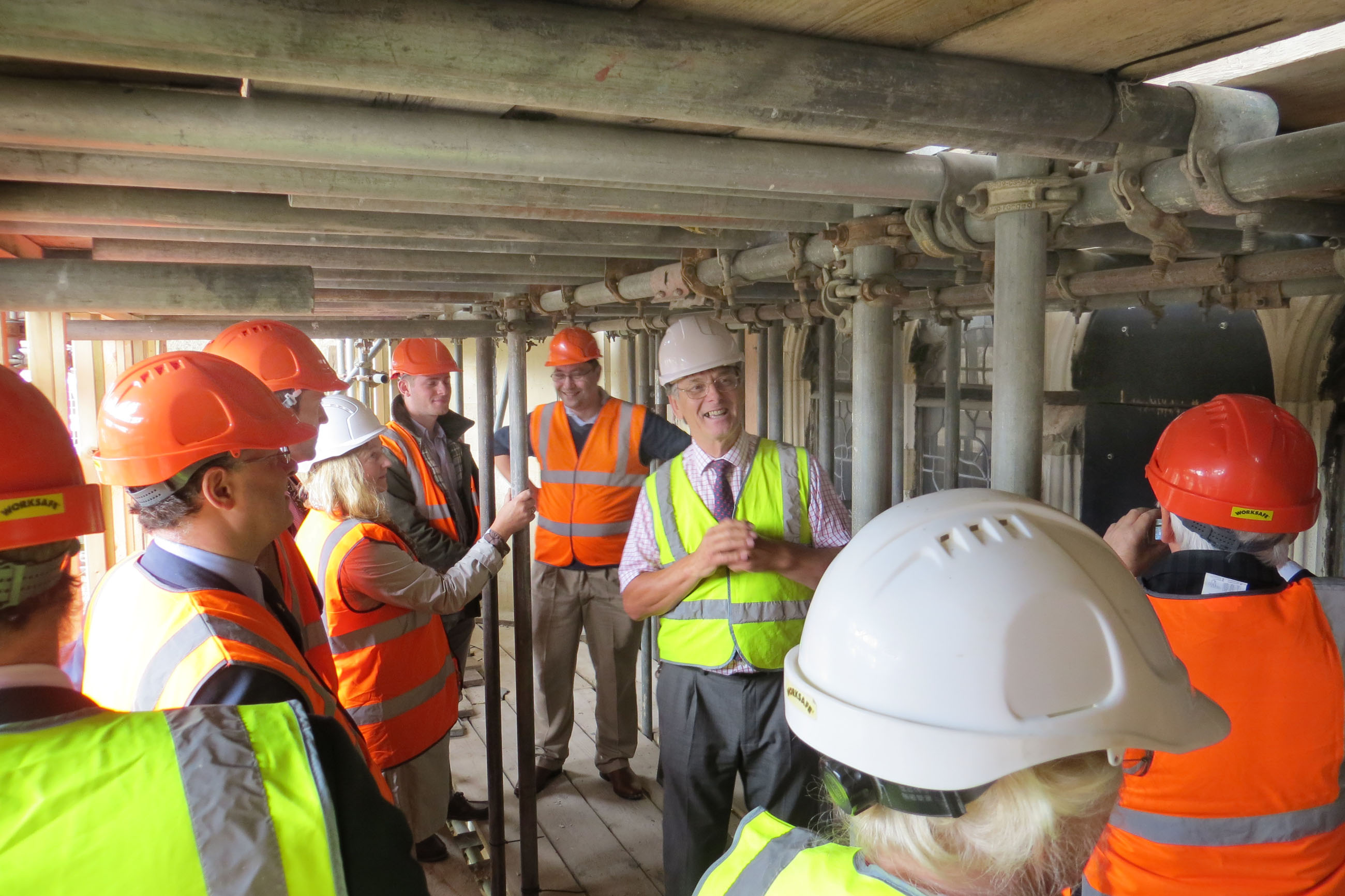As Canterbury Cathedral celebrates Christmas it will also be saying goodbye to John Burton MBE, Surveyor to the Fabric, after 23 years. One of John’s last projects has been to begin the repair of the Great South Window.
A lump of the tracery falling off the Great South Window at Canterbury Cathedral in 2009 provided a dramatic indication that the window needed some attention. It will be another two years before the work is finished and the scaffolding that is currently supporting the window can be struck to reveal the window now being rebuilt using Lavoux à Grain limestone (because it has bed heights of more than 1m needed for the mullions).
Caen limestone is also used at the Cathedral but the ‘B’ bed, used because tests show it most closely resembles the durable medieval stone of the Cathedral, is only available in bed heights of up to 300mm.
The stone is squared up by the supplier, Pierre de Paris, to minimise the amount of waste shipped. It goes to a site on the edge of Canterbury that the Cathedral bought more than 40 years ago because of the difficulty of getting lorries through the narrow, medieval streets of the city (Canterbury has even had to retain old fire engines because they are 228mm narrower than the latest models and the new ones cannot get into the Cathedral grounds).
The stone is sawn on a Gilbert wire saw that was bought by the Cathedral this year to work alongside its Wells Wellcut. Sometimes, some of the Cathedral’s 17 masons also work there rather than in the workshops at the Cathedral.
Specifying the work for the Great South Window was one of the last jobs of Purcell architect John Burton as Surveyor to the Fabric of the Cathedral.
As the new Archbishop of Canterbury, Justin Welby, celebrates Christmas this year, John Burton, who has been Surveyor to the Fabric for the past 23 years, hands over the role to his colleague at Purcell, Jonathan Deeming.
In May, Justin Paul Welby’s name was added by Cathedral mason Benn Swinfield to the stone in St Augustine’s Chapel on which are listed the now 105 people who have been Archbishop of Canterbury since the first, St Augustine, 1,400 years ago.
The role of Surveyor to the Fabric of such a huge, intricate and significant building, altered and repaired so many times in its long history, is wide ranging and complex.
The Surveyor is responsible for preparing the five-yearly survey, assessing the state of repair of the structure and making recommendations about the priority for repairs to the building. They are also responsible for health & safety, fire audits and disaster planning, as well as making representations to local and national planning and conservation committees.
It is a role that requires the architect to become almost as familiar with the stones used in the fabric of the Cathedral as the masons are, and a role that will be slightly easier for future Surveyors thanks to the great knowledge gained and recorded by John Burton during his tenure in the role.
He concedes that it was not always plain sailing and has involved some debate over the years – especially early on – with both the Cathedral authorities and conservation bodies about the best way to conserve the fabric of a building that is Grade I listed and a World Heritage Site.
The work John has been responsible for over the years has earned him the respect of the masons and conservators who carry out the never ending work of maintaining the mostly French limestone of the structure.
Heather Newton, Head of Stonemasonry & Conservation, says: “We have had a good working relationship with John – he really understands the building. I think I can speak for all the team when I say we are really sorry to see him go.”
John said: “Reflecting during the summer on my decision to retire as Surveyor, I realised that for more than 50% of my professional life I have been closely involved with Canterbury Cathedral – almost a third of my life! So you understand this has not been an easy decision – Canterbury Cathedral means a great deal to me. I’m proud to say I leave with the Cathedral leading the way in conservation, as the Mother Church should do. The team I have been associated with on a weekly basis are extremely well attuned to caring for this most outstanding building. I fear I will miss the very strong professional relationship that exists amongst the team as much as I will the Cathedral itself and its surrounding Precincts.”
Although most of the work on the Cathedral forms part of a predictable programme, there are times when something unexpected happens. A large piece of masonry falling from the tracery of the Great South Window, which houses some of Canterbury Cathedral’s priceless stained glass windows, was one of those occasions.
It was a hot day and the piece of falling masonry proved to be a warning that, as John Burton says: “The building was telling us it needed a new window.” Scaffolding was erected to hold it in place as well as to facilitate its repair.
What remains of Augustine’s original building today lies beneath the floor of the nave. The Saxon cathedral was destroyed by fire in 1067. The Normans built almost on its footprint, introducing Romanesque architecture to England. Since then there have been many revisions to the building as Canterbury has been at the forefront of changes in architectural style. It is one of the many reasons the building is so significant.
The Great South Window was added when the transept was rebuilt in the 1420s. Buttresses were added to support the wall but they were not joined to the foundations of the Cathedral. They were built on what appears to be a Roman road that ran next to the original building. There was also a medieval drain, which has now had a plastic liner inserted into it. The heat in 2009 seemed to be drying out the ground and leading to the failure of the window.
It is not a new problem. The Great South Window has been replaced once before and undergone a repeated cycle of repair every 30-60 years throughout its history. “We are hoping that the work being undertaken at the moment will break that cycle,” says Heather.
The current window is the result of the original being dismantled and rebuilt in 1792. A lot of the medieval fabric was retained. Where stone had to be replaced Portland limestone was used and the window was tied together with iron cramps.
Both the Portland stone and the iron cramps have contributed to the failure of the window since. The current work will see the iron replaced with stainless steel that has been lightly heat treated so it will rust a little on the outside to look like the old iron but not enough to impact on the stone. The Lavoux stone will sit comfortably with the retained stone. It has also been decided to use the medieval practice of putting lead joints between the stones of the tracery.
Hard mortar repairs to the window had also exacerbated the decay of the stone and there were other possible contributing factors. The building had been sprayed with shellac in the 19th century that had been intended to protect the stone but might have led to increased decay by trapping moisture inside the walls. And during World War Two, although the Cathedral escaped direct hits from bombs, the heat from a fire in a bombed building next to it damaged the south wall, which was repaired by drilling holes in the stone and pumping in hard cement-based mortar, which must also have considerably altered the migration of moisture.
Interestingly, monitors that have been positioned all round the building to record any movement have identified cracks in the stonework that rapidly open and close. Eventually it was realised the movement correlated with the ringing of the bells, their swinging as they were rung causing movement in the walls.
John Burton says the biggest problem at the Cathedral is with progressive creep of cracks in the masonry.
Replacement stones for the Great South Window are produced to the templates of Darren McCulloch-Smith in the drawing office. Heather Newton says nobody knows more about the window than Darren.
Darren describes his work as “really interesting – but challenging”. He says the window has moved and settled over the years. “There’s arcs that start at one centre and finish at another.” The current repairs are allowing some of the eccentricities of the window to be removed, but others have to be accommodated. For example, the window has a 60mm lean from top to bottom, which has to be retained so it will fit the jambs; the transoms are slightly convex while the cill is concave and the window opens up on the west side because of stairs inside the building. “The best we can do is put something back that’s more regular,” says Darren. “We have standardised the openings to 718mm. We will probably replace some of the springers on the tracery so we can make this change.”
A window that no longer needs to be repaired every few years is John Burton’s final legacy to the Cathedral. John Meardon, the Receiver General of Canterbury Cathedral, says: “John has been a meticulous Surveyor to the Fabric for nearly a quarter of a century and has looked after the Cathedral with devotion and much skill. I hope he will continue to visit us and see how our huge restoration programme is progressing.”
Giving masons a conservator’s perspective
Heather Newton, Head of Stone Masonry & Conservation at Canterbury Cathedral, was one of the three masons who instigated the formation of the Cathedral Workshop Fellowship that now offers a foundation degree course in Professional Development & Cathedral Stonemasonry with the University of Gloucestershire.  Steve Manual, the Apprentice Master at Canterbury Cathedral, is pictured here (right) with two of his apprentices concentrating on their coursework behind him.
Steve Manual, the Apprentice Master at Canterbury Cathedral, is pictured here (right) with two of his apprentices concentrating on their coursework behind him.
The Cathedral Workshop Fellowship was developed from an idea that came about when Heather was talking with John David, the Master Mason from York Minster, and Pascal Mychalysin, Master Mason from Gloucester Cathedral, in Pascal’s kitchen during the Gloucester carving festival of 1999.
Heather has an art college background and went on to become a youth worker in Toxteth, Liverpool. But her brother had become a stonemason at Salisbury Cathedral and the work appealed to her. Through her brother, she knew of the courses at Weymouth and went there to study stonemasonry. She worked at Canterbury Cathedral during the summer break. At that time, 25 years ago, stonemasonry was not generally considered appropriate work for a woman, whereas carving and conservation could be. So she returned to Weymouth to study carving and conservation in order to get a permanent job at the Cathedral.
“I have always thought we needed more formal training, with mentoring to help you learn and progress. Otherwise you’re forever leaning by making mistakes,” says Heather. That was the basis of the conversation she had with Pascal and John at the Gloucester carving festival in 1999 that led to the formation of the Cathedral Workshop Fellowship.
Heather: “If you have someone who’s not fully conversant with the latest thinking, they can cause a lot of damage on a building. But people have to feel they have ownership of the knowledge. There has been a lot of conflict between conservators and masons – there’s less now, although it still exists… snobbery and inverted snobbery, with masons considered ‘operatives’. We’re very anxious to close that gap and equip masons with the ability to view what they’re doing from a conservator’s perspective.”

